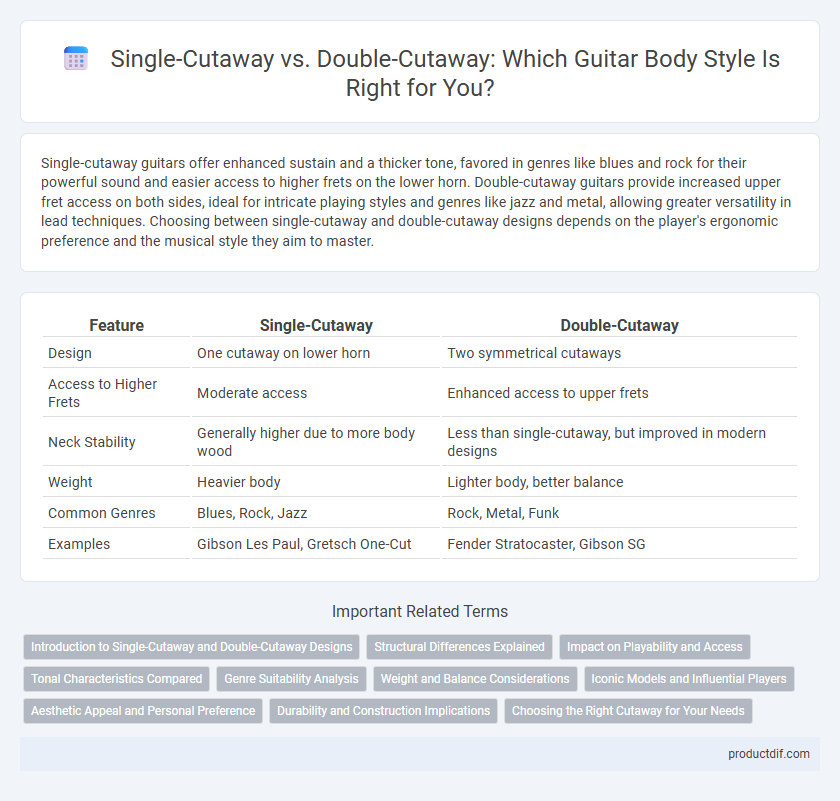Single-cutaway guitars offer enhanced sustain and a thicker tone, favored in genres like blues and rock for their powerful sound and easier access to higher frets on the lower horn. Double-cutaway guitars provide increased upper fret access on both sides, ideal for intricate playing styles and genres like jazz and metal, allowing greater versatility in lead techniques. Choosing between single-cutaway and double-cutaway designs depends on the player's ergonomic preference and the musical style they aim to master.
Table of Comparison
| Feature | Single-Cutaway | Double-Cutaway |
|---|---|---|
| Design | One cutaway on lower horn | Two symmetrical cutaways |
| Access to Higher Frets | Moderate access | Enhanced access to upper frets |
| Neck Stability | Generally higher due to more body wood | Less than single-cutaway, but improved in modern designs |
| Weight | Heavier body | Lighter body, better balance |
| Common Genres | Blues, Rock, Jazz | Rock, Metal, Funk |
| Examples | Gibson Les Paul, Gretsch One-Cut | Fender Stratocaster, Gibson SG |
Introduction to Single-Cutaway and Double-Cutaway Designs
Single-cutaway guitars feature a single horn-shaped cutout on the body, allowing easier access to the upper frets, commonly seen in classic models like the Gibson Les Paul. Double-cutaway designs have two symmetrical cutouts, providing enhanced playability and balance, typically associated with Fender Stratocaster guitars. Choosing between single-cutaway and double-cutaway designs depends on players' preferences for neck accessibility, tonal characteristics, and overall instrument aesthetics.
Structural Differences Explained
Single-cutaway guitars feature a single indentation on the body allowing easier access to higher frets on the lower horn side, while double-cutaway guitars have symmetrical indentations on both sides of the neck for unrestricted upper fret access. Structurally, single-cutaway designs often provide more body mass and sustain due to the larger overall body wood, whereas double-cutaway models prioritize playability with balanced weight distribution. The choice between single and double cutaways significantly impacts ergonomics, tonal characteristics, and playing style adaptability.
Impact on Playability and Access
Single-cutaway guitars provide enhanced stability and sustain due to their solid body design, offering limited upper-fret access that suits styles emphasizing rhythm and lower registers. Double-cutaway guitars feature symmetrical body cuts, enabling easier reach to higher frets and greater playing versatility for lead guitarists who frequently utilize upper fret positions. The choice between single-cutaway and double-cutaway designs significantly affects playability, with double-cutaways favored for complex solos and single-cutaways preferred for traditional playing comfort and tonal consistency.
Tonal Characteristics Compared
Single-cutaway guitars typically offer a thicker, warmer tone due to their larger body mass and denser wood distribution, which enhances sustain and bass response. Double-cutaway guitars often provide a brighter sound with increased upper-midrange clarity, as their design reduces overall body mass and allows for easier access to higher frets. Tonal differences between these styles are influenced by body shape, wood density, and construction, affecting resonance and frequency emphasis.
Genre Suitability Analysis
Single-cutaway guitars excel in genres like blues, rock, and jazz due to their enhanced sustain and thicker tone, providing powerful, warm sound ideal for lead playing and expressive solos. Double-cutaway guitars offer better upper fret access, making them preferred in genres such as metal, hard rock, and shredding-based styles where fast, technical playing and extended fretboard reach are crucial. The choice between single and double-cutaway designs significantly impacts playability and tone, aligning with specific genre demands and player techniques.
Weight and Balance Considerations
Single-cutaway guitars generally have a heavier body on the lower bout, which can cause a slight neck dive affecting overall balance during play. Double-cutaway designs distribute weight more evenly, providing better balance and reducing fatigue for extended playing sessions. Musicians seeking ergonomic comfort often prefer double-cutaways for their improved weight distribution and easier upper-fret access.
Iconic Models and Influential Players
Single-cutaway guitars like the Gibson Les Paul gained iconic status through players such as Jimmy Page and Slash, known for their powerful tones and sustain. Double-cutaway models, exemplified by the Fender Stratocaster, became influential in the hands of artists like Jimi Hendrix and Eric Clapton, prized for enhanced upper fret access and versatility. These designs continue to shape genres from rock to blues by offering distinct playability and sonic characteristics favored by legendary musicians.
Aesthetic Appeal and Personal Preference
Single-cutaway guitars offer a classic, streamlined look favoring traditional aesthetics, often preferred by players seeking a vintage or minimalist style. Double-cutaway designs provide a balanced, symmetrical appearance that appeals to those valuing modern, versatile visual elements in their instrument. Personal preference ultimately guides the choice, as the aesthetic appeal of single-cutaway versus double-cutaway shapes aligns with individual style and performance comfort.
Durability and Construction Implications
Single-cutaway guitars often feature a thicker body and fewer structural cuts, resulting in enhanced durability and increased resonance due to solid wood construction. Double-cutaway designs typically involve more intricate body shaping to allow better access to higher frets, which can slightly reduce overall body mass and affect the instrument's strength. Construction implications include reinforcement techniques like neck-through or set-neck joints to maintain structural integrity in double-cutaway models, whereas single-cutaway guitars generally rely on traditional bolt-on or set-neck designs that benefit from less body compromise.
Choosing the Right Cutaway for Your Needs
Single-cutaway guitars provide easier access to higher frets and typically deliver a thicker, more resonant tone favored in genres like blues and rock. Double-cutaway guitars offer greater upper fret accessibility and improved balance, making them ideal for lead players who require versatile playability across styles such as jazz and metal. Selecting between single-cutaway and double-cutaway designs depends on your playing style, genre preference, and ergonomic comfort during performance.
Single-cutaway vs Double-cutaway Infographic

 productdif.com
productdif.com